This is an archive of information released in the past.
Disclaimer: It may contain broken links or outdated information. Some parts may not function in current web browsers.
*Visit https://humans-in-space.jaxa.jp/en/ for the latest information.

Experiment
- News
- Kibo Utilization Strategy
- Kibo Utilization Plan
- List of JAXA's Utilization Themes
- Experiment Facilities
- Space Environment Utilization
- Archive
International joint research Matryoshka-R experiment has started on board Kibo
All times are Japan Standard Time (JST)
Since May 21, 2012, Matryoshka-R Ball-Type Phantom experiment has been started on board the Japanese Experiment Moduke, Kibo. The experiment measures deep body radiation to conduct risk assessment for astronauts and cosmonauts caused by space radiation exposure.
Execution and onboard operation of the experiment are conducted in accordance with the international joint research agreement among JAXA, Federal Space Agency (FSA), Institute of Biomedical Problems (IBMP), and RSC Energia. Three experiments are scheduled between 2012 and 2016, and this time is the first one.
What is the Matryoshka-R Ball-Type Phantom?
The Matryoshka-R Phantom is aboard the International Space Station (ISS) since 2004, the hardware for conducting space radiation measurement experiments. The basketball-sized, ball-type hardware (370x370x390 mm, 32kg) is made from human tissue-equivalent materials.
20 bar containers are able to be inserted into the Phantom. There are 32 pockets attached to its surface cover made from human tissue-equivalent materials. Dosimeters are to be inserted into the bars and pockets.
The series of experiments have been conducted in Zvezda (the Russian segment) and in the Pirs Docking Compartment (DC-1) since 2004. This time Matryoshka-R Phantom has installed in Kibo for the first time.

Matryoshka-R Ball-Type Phantom experiment hardware
Launch of Dosimeters aboard the Soyuz Spacecraft (30S)
For Matryoshka-R experiment, Russian and Japanese dosimeters are used. Dosimeters used for this time have launched aboard the Soyuz TMA-04M spacecraft (30S) from the Baikonur Cosmodrome on May 15, 2012. Along with these dosimeters, Area PADLES (Passive Dosimeter for Lifescience Experiments in Space), dosimeters for measuring the space radiation environment at fixed points in Kibo, were also aboard. Researchers of radiation measurement experiments in Japan also participated in the preparation processing at the Baikonur Cosmodrome.
The experiment preparation was conducted in the laboratory at Baikonur Cosmodrome. This building is well known for its glass-walled room; the room used for press conference on the day when astronauts and cosmonauts go aboard the Soyuz spacecraft.
Space experiment facility, Building 254, in Baikonur

Booth used for press conference by crew on the eve of a launch
Final checkout of dosimeters before loading the spacecraft.
(Nagamatsu, an associate Senior Engineer of JAXA (second from left) and responsible members from RSC Energia)

Soyuz rocket is rolled out by train on its way from the Launch Vehicle Integration and Checkout Facility to launch pad
Soyuz rocket is lifted on to the launch pad
(Soyuz spacecraft (30S) with PADLES dosimeters is fitted into the payload fairing)

PADLES dosimeter will be set in a bar container to insert into a ball
PADLES dosimeter set in a bar container to be inserted into a ball
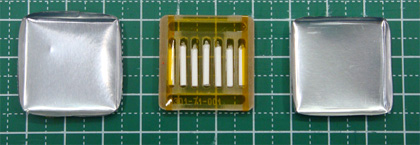
PADLES dosimeter to be put in surface cover pockets
Installation to Kibo
Russian cosmonaut Oleg Kononenko took out the Ball-Type Phantom stored in the Zvezda and installed it to F2 rack in Kibo's Pressurized Module (PM). This installation became the first experiment task performed by a Russian cosmonaut in Kibo.
The Phantom will be exposed to the space radiation for about four months, and only dosimeters will be returned to Earth by the Soyuz spacecraft (30S). After collected on the ground and returned, PADLES dosimeters will be analyzed in the laboratory at the Tsukuba Space Center.

Matryoshka-R Phantom installed to F2 rack (Credit: JAXA/FSA)
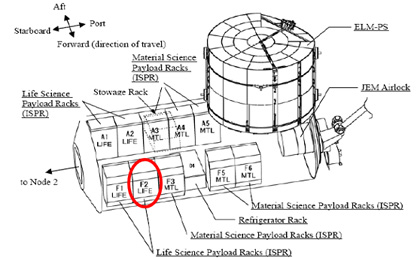
Location of Matryoshka-R Phantom (at F2 rack)
The purpose of this experiment is to assess the effects to human body as a result of space radiation absorption by simulating the surface and deep part of human body. Obtained data will be used for several purposes, to improve the accuracy for assessing unmeasurable exposed dose in deep part of human body and the risk assessment. The data also will be the fundamental data for developing a simulation program that predicts radiation dose for the next-generation human space activities (at outer magnetosphere.)
Reference:
*All times are Japan Standard Time (JST)
| Copyright 2007 Japan Aerospace Exploration Agency | Site Policy |